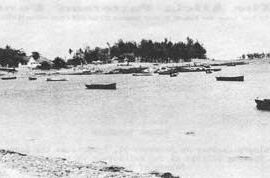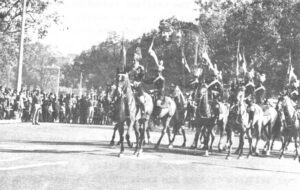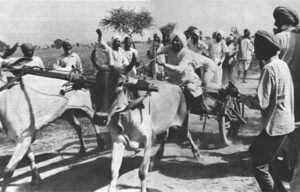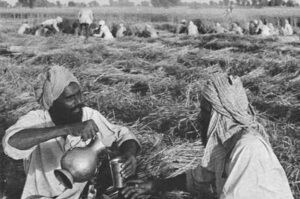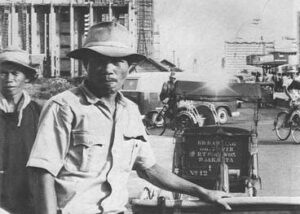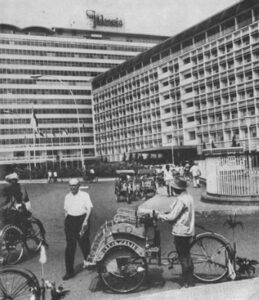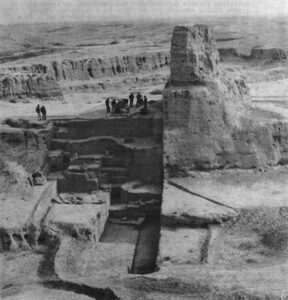Rome
May 2, 1971
The disintegration of Pakistan. The collapse of a government in Turkey. Heightened rural violence in the Philippines.
Is it mere coincidence that political explosions have followed spectacular advances in agricultural production in all three countries?
From the perspective of the Food and Agricultural Organization’s global conning tower in Rome the answer seems to be no. The civil war in Pakistan, especially, has led to a sober reappraisal, not only of the “green revolution” based on the new dwarf grains, heavy fertilization and irrigation, but of the widely accepted view that, breakthroughs in food output have given the world twenty or thirty years “breathing space” in which to check population growth.
Although the evidence is still very tentative, FAO policy planners and economists are beginning to fear that runaway population growth is once more edging ahead in the race with world food production.
Indeed, the slowdown of the green revolution, its failure to take hold in some regions with the most severe population problems such as North Africa and the political turmoil it has helped to generate where it has been dramatically successful have led the FAO’s director general, the Netherlands’ A. E. Boerma, to restudy the U.N. organization’s Indicative World Plan, a master blueprint on how to avert world famine in the next 15 years.
The IWP, presented to the second World Food Conference at the Hague a year ago, aimed to “indicate” to poor countries what they should do; it is used as a future yardstick by most governments and development agencies.
The problem the IWP starkly set forth was that if the present population growth rates of 2.5 to 3.5 percent a year continued in the poor countries until 1985 and the economic growth rate stayed at the roughly 2.7 percent present level, food supplies would have to rise 80 percent just to avert famine in some regions. It would cost the poor countries in 1985 some $26 billion a year to import the additional food they would need, a clear impossibility since they barely are able to scrape up $3 billion a year for their food imports now. While Afro-Asia’s cities would grow astronomically, the IWP estimated 400 million of the extra 1 billion people by 1985 would still be left in an increasingly destitute countryside.
When the IWP was completed after six years preparation in October, 1969, FAO policy planners in Rome told me they felt the main problem ahead, in the wake of the green revolution would be a lack of cash in the pockets of large unemployed masses of the world’s people, a lack which would translate itself into little effective demand or into markets that would motivate peasant farmers to adopt the new technology and grow more. The emphasis in the IWP was not so much on simply growing food but on finding jobs for the legions of predicted unemployed.
The IWP was based on the assumption, especially wide spread during the burst of euphoria following the first record wheat and rice harvests of the new dwarf grains, that the average annual incomes of the world’s peasants ($43 for an African, $46 for an Asian) would continue to gradually rise.
Now, two years later, FAO economists have been alarmed to find no real evidence that rural incomes have increased. The IWP’s central prediction was that food demand would rise 140 percent from 1962 to 1985, two-thirds from population increase and one-third from rising incomes. Now it looks as if close to the total demand for food may come from population growth alone. Since 1969, the green revolution has led to a marked increase in agricultural output in much of the Far East and certain scattered regions such as the Punjab plain of northern India and West Pakistan. But elsewhere in the, world, there are ominous signs appearing that there may have even been an actual net decline in food output.
As one FAO official summed up the situation: “The projections on which the IWP were made have proved too optimistic. Maybe current trends are only temporary. But if they continue our whole prediction of food demand could be wrong. Two years ago we considered feeding people the problem of the 1960s and finding them jobs the problem of the 1970s. Now we might be back to the old question.”
What has gone wrong?
The trouble stems from the precise nature of the green revolution.
The phrase “green revolution” was coined to describe the truly spectacular change in farming methods and village ways of life which have taken place in certain key world regions since 1965 where a transfer of technology proved relatively easy. The new technology centered on the breakthrough in plant genetics – a purely scientific phenomenon – which enabled man to breed artificially short, stiff stemmed wheat, rice and maize which could take large amounts of nitrogen and support heavy grain heads without falling over or lodging under their own weight.
How rapidly and how widely this technology could be transferred to poor countries could really only be guessed at five years, or even two years, ago.
It is only now beginning to be clearly evident that this transfer of technology requires for success a fairly homogeneous farming population culturally and psychologically prepared for change and progress, the existence of some degree of rural capital, careful water control which by and large confines the more spectacular advances in grain production to irrigated, areas and wise politics such as, say, land reform, which are carried out in advance to ensure that the benefits of the new technology are widely distributed so as to avoid a social explosion.
Such conditions have proved harder to come by than was originally hoped. They may exist in South Korea and Taiwan where the new rice has been almost universally adopted, with no apparent social dislocation (both of these highly regimented societies have also had exceptional success with government-sponsored family planning programs unlike the really big countries such as India, China and Indonesia where it really counts; India’s claim that its family planning program is working since the 1971 census reported 15 million less Indians then anticipated should be taken with a grain of salt. In India’s Punjab and a few neighboring states, a 30-acre land ownership ceiling enacted in the fifties, a progressive, shoulder to shoulder, relatively equalitarian and not too dense farming population and an abundant supply of underground and canal water created ideal conditions for growing the new dwarf wheat. But elsewhere some vital ingredient, either technical or social, has been lacking. The story of Pakistan, Turkey and the Philippines is to a large degree one of politics failing to keep pace with technology.
It is now possible to redefine the green revolution. It is a transfer of farm technology limited largely to irrigated, capitalized areas of the poor world which by its nature should not have been expected to fulfill the social needs of the poor nations. Indeed, it probably should have been more apparent from the first that it would aggravate them.
In effect it has meant subsidizing rural capital, thus creating a growing distortion between the cost of capital and labor in agriculture. FAO economists now take it as a rule of thumb that any major transfer of technology without social leveling is politically explosive.
That this is true is not to deny that the continued rapid transfer of Western farm technology – and it has been primarily American farm technology – to the poor countries is an absolute necessity. When every ten seconds four people die of malnutrition, when about 190,000 join the number of earthlings each day, and when such statistics are translated into the reality of stagnant agriculture, a global flood of peasants inundating the large cities, unemployment mounting everywhere and the uprooting in a very short space of time, of the social and cultural underpinning of millions and millions of people, there is no alternative to plunging ahead.
But a real danger now has emerged that if science cannot develop new varieties for more crops, especially for marginal dry farming areas, or politics cannot devise more equitable distribution of wealth and regional economic groupings, there is a serious possibility that the first dramatic, five year phase of the green revolution could look in retrospect like a historical accident.
Some loss of momentum was always anticipated. From the beginning agricultural technicians and development economists foresaw such “second generation problems” as the need for more research and adaptability of seeds, better storage and marketing facilities, water supplies and availability of pesticides and fertilizers, wiser price policies, increased transportation.
What was not adequately foreseen – possibly because those mostly involved in the green revolution were technicians and scientists not sociologists or anthropologists – was the often convulsive social impact when the introduction of the new technology and the resultant shift to a rural money economy very suddenly widened the gap between the rich and poor in the countryside or between rich and poor regions in a country.
To get down to specifics. The case of Pakistan. Two years ago at the World Bank headquarters in Washington I first heard predictions that the green revolution in Pakistan would figure significantly in the breakup of the country. Similar predictions are being made today of a possible violent revolution in West Pakistan itself whether the Punjabis succeed in holding on to East Bengal or not.
In a purely technological sense, West Pakistan has been the number one success story of the green revolution. It made the most spectacular increases in cereal production since 1966 ever recorded since man first started growing wheat between nine and eleven thousand years ago, increasing its harvest nearly 60 per cent from 1967 to 1969. This brought Pakistan, before the present trouble, close to self sufficiency in cereals, including rice, after almost twenty years as the second largest recipient of American food aid. West Pakistan’s farmers have doubled or tripled their wheat yields and with only half of 40 million acre feet of underground water so far tapped by tube wells and only half of 10 million irrigated acres sown in the new seeds, future progress could be doubly spectacular.
But the green revolution is not a story of technology alone. As noted in an earlier report, one fact alone comes close to telling why things have gone wrong in West or Pakistani Punjab and right across the border in Indian Punjab. Before the green revolution, laborers – who by far outnumber land owners traditionally got one out of every 20 bales of wheat they harvested, enough to feed their families for a year. With higher yields, harvest earnings on the Indian side, have been, admittedly with some rough and tumble, adjusted relatively proportionately. In Pakistan, where governmental legal restraints on exploitation of the poor are considerably less than in India, landless laborers have more or less been kept to the old absolute amount of wheat harvested. Or put another way, a landless laborer’s income in West Pakistan today is still just about what it was five years ago, less than $100 a year. In contrast, one landlord with a l,500-acre wheat farm told me when I was in Pakistan this winter that he had cleared a net profit of more than $100,000 on his last harvest; there are thousands of landlords with substantial holdings in West Pakistan in contrast with Indian Punjab where anything over 30 acres was a rare novelty.
Almost everyone I met in Pakistan, Pakistani or foreign, believed it was this growing gap between the rural rich and poor that won Z. A. Bhutto and his Pakistan People’s Party their election victory last December. Almost as prevalent was the feeling that, the leftward swing by West Pakistan’s voters and the virtual elimination of Moslem conservatism as a political force was but the curtain raiser in what could become a much more violent social revolution. There is now considerable informed speculation whether President Yahya Khan and Bhutto themselves can avoid being swept aside if and when things start to go in favor of the Bengali secessionists during the rainy season.
The brutal civil war itself provides a second illustration of the explosion to be expected when a transfer of technology is not accompanied by social leveling. While its agricultural advances gave West Pakistan, after Japan and Iran, the fastest economic growth rate in the world, steamy East Bengal has stagnated and many of its farmers have grown poorer in recent years.
There could be no green revolution in East Bengal because some 60 percent of the country goes under water during the summer monsoon and so did the new short-strawed rice.
Actually, the disintegration of the Bengali village on both sides of the frontier (like Punjab, Bengal was divided down the middle between India and Pakistan in 1947) can probably be dated back to the early 1940s, before India’s independence from Great Britain. In some of the most densely populated districts such as Noahkhali and Comilla, there has been a steady regression in agricultural methods over the past thirty or forty years. Since no Bengali land holding of less than 1.5 acres can support a pair of bollocks and the average farm size of 1.7 acres hides the reality that half of the holdings are less than half an acre, Bengal has witnessed a steady retreat from oxen-pulled plows to primitive hand hoes, a sort of green revolution in reverse. The psychological effect of such dense overcrowding and technological regression has never been folly studied, but Noahkhali will be remembered as the scene of Mahatma Gandhi’s last pilgrimage to try and prevent a slaughter of Moslems and Hindus that, together with similar fighting in the Punjab, cost an estimated million lives. (The only other comparable bloodbath in modern times took place on the similarly densely populated islands of Java and Bali in the anti-Communist massacre of 1966.)
In both East and West Bengal during the past five years there has been a steady growth of movements, fed by dispossessed peasants without bollocks, money, land or hope, to seize land from others by force. These Naxalite gangs, named after the village where the land grab movement first began, have been roaming about, killing, looting and condemning landlords by “people’s courts” on the old Chinese pattern. Until recently these gangs defined a “landlord” as a peasant with more than five acres. The present trend is to reduce this to three acres.
The obvious danger facing both the Indian and Pakistani governments is that the East Bengali Marxists will succeed in wresting away the leadership of the secessionist battle from the imprisoned Sheikh Mujibur Rahman and his moderate Awami League and then join forces with their counterparts in West Bengal. This would raise the possibility – perhaps spectre is the better word – of the two Bengals uniting in a new, independent, extremely leftist and probably ungovernable republic.
It is fear of this happening, which would cut off oil-rich Assam from the rest of India, that seems to be determining New Delhi’s reaction to events in East Bengal. Prime Minister Indira Gandhi’s basic interest seems to lie in trying to help East Bengal’s middle class what there is left of it after the battles in Dacca and elsewhere survive politically, with or without association with West Pakistan and prevent violent revolutionaries from taking over and teaming up with India’s Calcutta-headquartered Marxists.
Mrs. Gandhi certainly seems alive to the dangers of overt, official support for the Awami League and has warned Indians that “one wrong step or one wrong word may have an effect entirely different to what we all intend.” But she may be tempted to recognize Bangla Desh should guerrilla warfare break out again in earnest if it becomes the only way to help its middle class survive, even at the risk of gaining real and open enmity or even going to war with West Pakistan.
Even without the oil of Assam, India has reasons in terms of its own national survival to fear the emergence of a united, revolutionary Bengal.
If five years of rapid agricultural advance in its western wing amidst continued agricultural stagnation and decline in its eastern wing figured significantly in the breakup of Pakistan (and breakup it is no matter how long Punjabi troops forcibly occupy East Bengal), then it seems reasonable to expect similar trouble in India where similar economic forces are at work.
A member of India’s planning commission told me some months ago that in all probability the green revolution would create a stable, prosperous agriculture and peasant society in about five or six of India’s 17 states, centering around the northern wheat belt and Punjab. But in the rest of the country, where there is either dry farming or wet rice cultivation, the effect of the northern wheat belt’s prosperity might be negative, just as Iowa’s prosperity was attained partly at the cost of poverty in Appalachia. My own feeling is that, just as the two Bengals are being pulled together by their mutual misery and revolutionary politics – the politics of desperation really – so one can expect West Pakistan, India’s Punjab and parts of Uttar Pradesh, Rajasthan and a few other neighboring states to be drawn together by agriculture-based economies that are prospering at fantastic rates and creating a way of life that may soon approach that of southern Europe. In other words, there seem to be compelling forces at work to redraw the map of South Asia not on religious lines, as was done in the partitioning of India in 1947, but on agricultural lines with the irrigated, prospering, wheat producing regions of India and Pakistan uniting out of common economic interests and standards of living. A cry of “We Punjabis” seems almost as inevitable as that of “We Bengalis.” (It is the Punjabis throughout northern India, not only in Punjab itself, who have by and large carried out the green revolution.)
For this reason perhaps, sensing the trouble ahead as its irrigated agriculture prospers and its dry farming and rice areas stagnate or even regress, India seems, like China in 1948, to be turning inward, rejecting foreign influence of all kinds and moving to isolate itself from the world much more than in the past. In few countries does one sense such disillusionment with the West, particularly the United States. For a brief golden period, from the late 1950’s until the mid-1960’s, there seemed to be a moment when it appeared the rich nations, led by Americans, might accept the same kind of shifting of resources from rich to poor as had happened within Western society itself in the late 19th and early 20th centuries. Now instead the flow of concessionary capital to the poor countries is sharply diminishing and the green revolution is creating as many problems as it is solving.
This may sound depressing. But I covered Asia as a correspondent during these years, 1959 to 1967, where there was a more evident element of hope about the future, and confidence in the United States to lend a helping hand. I am not sure I would like to cover Asia now.
If India is to be helped to survive as an open society, the place to start is probably East Bengal. The region is not entirely hopeless, if political stability is restored and economic assistance is provided for its agriculture. One possibility would be the development of a new high-yielding floating rice and researchers are already at work. Another would be to get the annual floods of the Ganges and Bramaputra under control so that already existing new high yielding rice varieties could be used.
A massive engineering effort is required, including the construction of enormous embankments, irrigation systems and the establishment of an extension service to train Bengali peasants in the new methods of rice cultivation. The flood waters of the Ganges and Bramaputra are two and a half times greater than those of the Mississippi and Missouri rivers. In 1968, when the potentialities of the new dwarf rice were fully seen, there was talk in Dacca of constructing a massive flood control system within seven to ten years. Nothing was done and to some degree East Bengal’s jute exports continued to pay for West Pakistan’s industrial development. Two-thirds of some $600 million or so in foreign aid received each year also went to the western wing, Technically, industrialization of the west made sense since its shifting waterways and the lack of any real infrastructure of road and rail communications were genuine drawbacks in Bengal. But, in retrospect, as average rural incomes rose two-thirds higher in the west than in the east, it seems extremely shortsighted of the Pakistan government not to have at least began a massive flood control program (which also would have helped provide jobs.) Perhaps it is not too late to start now.
Outside of Pakistan, the green revolution’s greatest technological success and human failure, there is no such insistent pattern.
In the Far East, the Philippines, after recording its first exportable surplus in history in 1968 end four record rice harvests in a row, is back importing rice again, buying 300,000 tons of Japan’s seven million ton rice surplus (created by the Sato government by jacking up prices to keep Japan’s farmers happy.) President Marcos wanted the Japanese rice to depress local prices which have doubled in the past three years; the alternative was to let high local rice prices inflame the rural population, where Maoist guerrillas are reportedly gaining supporters among the poor and landless at a rapid pace. With some 400 families controlling 90 per cent of the country’s wealth, the most inequitable land distribution outside Latin America and the gap between the rich and poor widened by the new rice, the Philippines rivals only Pakistan as an example of what can go wrong in the transfer of technology without accompanying social leveling.
Elsewhere in the region, Indonesia is fighting an uphill battle to get its reluctant peasantry to adopt the new rice; President Suharto has virtually staked his regime’s survival on growing enough food to divert $60 million a year now spent on importing rice into job-creating industrialization. A widely forecast rice surplus in Southeast Asia has not materialized. Thailand and Burma have not planted the new varieties and Ceylon and Malaysia have developed their own intermediate ones.
In the wheat belt from Afghanistan to Morocco the green revolution has not taken hold as expected for many reasons. Some countries, such as Afghanistan, have the research and the seeds but not the population pressure nor administrative ways and means to adopt the new varieties on any large scale. (The two are of course linked; Afghanistan’s population is stable because it still has a very high infant mortality rate. A country so remote that modern medicine hasn’t reached into most of its villages is not ready for any major transformation of its agriculture either. Iran, perhaps with a worried eye on Pakistan, has been very cautious about pushing the new wheat. Iraq and Syria have been more enthusiastic and are making modest progress. Egypt, which has the world’s best conditions for growing the dwarf wheat, and conceivably could triple its present fairly good yields of three tons an acre, appears to be stalled until there is a peace settlement. FAO experts, however, discount alarm voiced by ecologists that the Aswan Dam, by stopping the flow of silt down the Nile River, has ruined the fertility of the Nile delta. They spy almost all the land can be preserved with proper engineering and drainage. Nonetheless, with a population that has skyrocketed from 25 million ten years ago to 38 million now, Egypt is felt to have one of the worst lebensraum problems in the world; one hears the surprising prediction the Egyptians may one day have to spill over into Lybia and the Sudan.
In the eyes of some FAO economists, the Maghreb – Morocco, Algeria and Tunisia – may be facing the worst population/food crisis in the world. In some areas real income is actually declining. Morocco alone has a 40 percent unemployment rate, with Tunisia and Algeria not far behind. The FAO estimates it would cost about $4 billion a decade to intensify agriculture in North Africa since there is only a single winter growing season, little irrigation and very little potential for producing more calories per acre. In per unit of land terms, the potential for growing more food in North Africa is only 50 percent of what it is in rain fed monsoon Asia. One solution would be irrigation. But the potential for irrigation for all North Africa is only one-half (on a per capita basis) of the 22 million hectares India already has under irrigation. The FAO predicts the population of North Africa and the Middle East more or less the Arab world – will grow from 200 million to 300 million by 1985. Said one expert, “It is hard to see much of a, future for the region except twenty to thirty years of misery coupled with immigration unless and until it becomes fully industrialized and integrated into the Mediterranean trade world.”
With the exception of Kenya (where new maize varieties have been tried) and Mexico (where the new wheat was first developed, enabling Mexico to feed a doubled population since 1944 and still have an exportable surplus of 700,000 tons last year), Africa and Latin America have taken almost no part in the green revolution, simply because there is little irrigated farming.
What happens now?
I think it can safely be said that the green revolution’s first dramatic five-year phase is over. The transfer of technology will continue, of course. How fast will depend on the generosity of the West and whether the recommendations of the Pearson Commission Report, the resolutions of UNCTAD, the Pope’s Encyclicals and others are followed so that the rich countries contribute one per cent of their gross national products in aid to the poor countries, to insure more stable prices for their primary products, increase their liquidity, provide more technical assistance and so forth. What is clear now is that to successfully transfer Western farm technology to the poor countries is going to cost a lot more money from the rich countries and a lot wiser social policies from the poor countries than it might have seemed a year or two ago. Nothing can stop the green revolution. The question is how red it becomes.
Received in New York on May 6, 1971
©1971 Richard Critchfield
Mr. Richard Critchfield is an Alicia Patterson Fund award winner on leave from the Washington Evening Star, Washington, D.C. This article may be published with credit to Mrs. Critchfield, the Washington Star and the Alicia Patterson Fund.

